What factors influence the financial sustainability of microfinance institutions in Sub-Saharan Africa?
Inhaltsverzeichnis (Table of Contents)
- Introduction
- Theoretical Perspective
- Financial Systems Approach
- Poverty Lending Approach
- Approach
- Data Source
- Data Filtration
- Statistical Analysis
- Findings
- Implications
- Limitations and Further Research
Zielsetzung und Themenschwerpunkte (Objectives and Key Themes)
This research aims to analyze the factors influencing the financial sustainability of microfinance institutions (MFIs) in Sub-Saharan Africa. The study explores the relationship between financial sustainability and outreach, examining whether a trade-off exists between these two factors. Additionally, it identifies key indicators influencing financial sustainability and investigates their impact on operational self-sufficiency (OSS).
- Financial sustainability of MFIs in Sub-Saharan Africa
- Trade-off between financial sustainability and outreach
- Key indicators influencing financial sustainability
- Impact of indicators on operational self-sufficiency (OSS)
- Comparison of financial systems approach and poverty lending approach
Zusammenfassung der Kapitel (Chapter Summaries)
- Introduction: This chapter provides an overview of the research topic, outlining the importance of microfinance in Sub-Saharan Africa and the need for financial sustainability. It introduces the research question and highlights the existing gap in knowledge.
- Theoretical Perspective: This chapter presents two contrasting approaches to microfinance: the financial systems approach, which prioritizes operational self-sufficiency, and the poverty lending approach, which emphasizes poverty reduction through credit. It discusses the arguments and criticisms surrounding each approach.
- Approach: This chapter details the methodology used in the research, including the data source (Microfinance Information Exchange), data filtration process, and statistical analysis techniques. It explains the specific methods employed, such as ordinary least squares (OLS) regression analysis.
- Findings: This chapter presents the results of the data analysis, exploring the relationship between outreach and financial sustainability. It examines whether operationally self-sufficient MFIs have a larger outreach and analyzes the correlation between different financial indicators and OSS.
- Implications: This chapter discusses the practical implications of the findings, highlighting the factors that contribute to financial sustainability and the challenges associated with achieving it. It emphasizes the importance of key indicators and their potential impact on MFI performance.
Schlüsselwörter (Keywords)
The study focuses on microfinance, financial sustainability, outreach, operational self-sufficiency (OSS), financial systems approach, poverty lending approach, Sub-Saharan Africa, microfinance institutions (MFIs), return on assets, number of active borrowers, profit margin, OLS regression analysis, Microfinance Information Exchange (MIX Market), and data filtration.
- Quote paper
- Hanna Kattilakoski (Author), 2018, Financial Sustainability of Micro-Finance Institutions in Sub-Saharan Africa, Munich, GRIN Verlag, https://www.grin.com/document/594236



